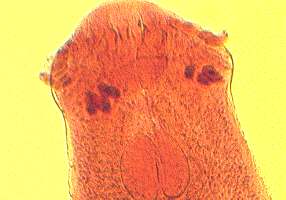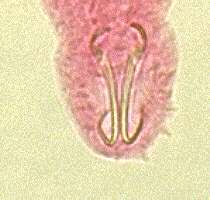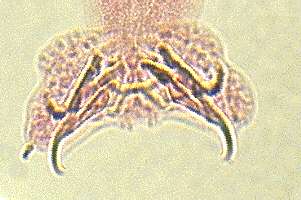
Spines are short, straight, hardened structures that protrude from the surface of the parasite. They are usually numerous and aid attachment by providing a rough surface that may penetrate host tissue.
Echinostome trematodes such as Echinostoma (top) and Petasiger (bottom) have prominent oral spines (O) as well as body spines (B).


Hooks are short, curved, hardened structures that protrude from the surface of a parasite. They are usually numerous and aid attachment by penetrating host tissues. Their curvature provides tremendous anchoring power. They are often under muscular control.
Hooks are important components of the acanthocephalan proboscis.

Tapeworm oncospheres have hooks (H) that help them penetrate the intestinal wall of the first intermediate host.

Hooks in action. The scolex of Triaenophorus, in addition to bothria, has hooks. Note the curvature and how the hook actually penetrates into host tissue.

Anchors are large, complex hardened structures, curved to penetrate and grip host tissue. They are usually paired structures, under muscular control.
Many monogeneans have anchors as the primary attachment device on their opisthaptor.


Claws are adaptations of the terminal portion of appendages. They are usually curved and jointed to permit opening and closing around host hair, feathers or other tissues.
Antenna of Ergasilus modified as a claw.

Human crab louse, which lives within coarse hair, has a large claw adapted for grasping large diameter hairs.

The small, bifurcated claw on Lipoptena is modified little over the claws on free-living flies.
